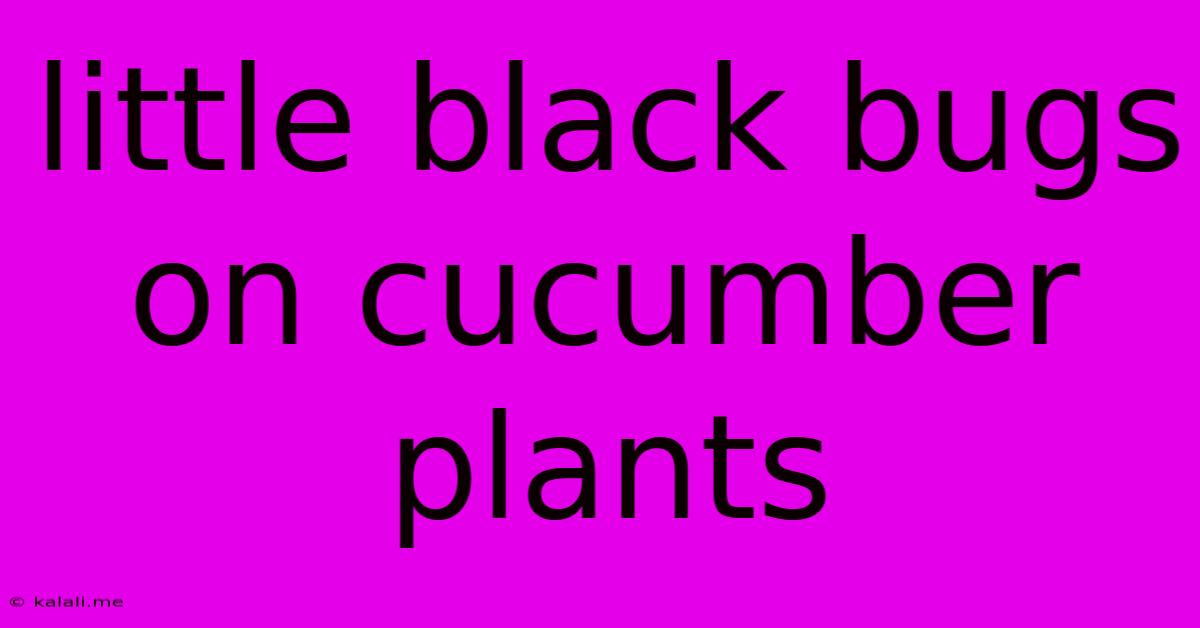Little Black Bugs On Cucumber Plants
Kalali
May 31, 2025 · 3 min read

Table of Contents
Tiny Black Bugs on Your Cucumber Plants: Identification and Control
Are you battling tiny black bugs on your cucumber plants? These unwelcome guests can quickly decimate your harvest, leaving you with fewer cucumbers and a lot of frustration. This comprehensive guide will help you identify the culprits and implement effective control strategies to save your precious plants. We'll cover common culprits, prevention methods, and natural and chemical control options, ensuring you have a bountiful cucumber harvest this season.
Identifying the Black Beetles on Your Cucumbers
Several tiny black insects could be plaguing your cucumber plants. Correct identification is key to effective treatment. Some common suspects include:
-
Cucumber Beetles (Diabrotica spp.): These are among the most common and destructive pests. They're typically striped (the spotted cucumber beetle is an exception) and feed on leaves, stems, and even the fruit itself, causing significant damage. Their larvae also feed on the roots.
-
Aphids: While not always black, some aphid species can appear dark. These tiny, pear-shaped insects suck sap from the plants, weakening them and potentially transmitting diseases. Look for clusters of them on the undersides of leaves.
-
Thrips: These slender, winged insects are also sap-suckers. They cause stippling and silvering on leaves, and their feeding can deform young fruits.
-
Black Bean Aphids: These aphids are specifically known for attacking cucurbits. They form large colonies, causing leaf curling, wilting, and stunted growth.
-
Other Beetles: Various other small black beetles might infest cucumber plants, so close observation is necessary to properly identify the specific pest.
Damage Caused by Black Bugs on Cucumbers
The damage caused by these tiny invaders varies depending on the species. However, common signs include:
- Holes in leaves: Cucumber beetles, for example, are notorious for chewing holes in cucumber leaves.
- Wilting and stunted growth: Sap-sucking insects like aphids and thrips weaken the plant, leading to stunted growth and wilting.
- Deformed fruits: The feeding activity of some insects can deform young cucumbers.
- Yellowing and discoloration of leaves: Leaf discoloration is another common sign of pest infestation.
- Sooty mold: Aphids secrete honeydew, a sticky substance that encourages the growth of sooty mold, a black fungus that further affects plant health.
Effective Control Strategies for Black Bugs on Cucumbers
Controlling these pests requires a multi-pronged approach combining prevention and treatment.
Prevention:
- Crop Rotation: Rotating crops helps disrupt the life cycle of many pests.
- Cleanliness: Remove plant debris and weeds around your cucumber plants to eliminate overwintering sites.
- Healthy Plants: Healthy plants are less susceptible to pest infestations. Ensure proper watering, fertilization, and sunlight.
- Row Covers: Using floating row covers can prevent many insects from accessing your plants, especially in the early stages of growth.
Control Methods:
- Handpicking: For small infestations, manually removing insects can be effective.
- Insecticidal Soap: This is a safe and effective option for many soft-bodied insects like aphids.
- Neem Oil: Another natural insecticide effective against many common garden pests.
- Diatomaceous Earth: This natural powder dehydrates insects upon contact. Apply carefully to avoid inhalation.
- Beneficial Insects: Introduce beneficial insects like ladybugs, lacewings, and parasitic wasps to your garden to control pest populations naturally.
- Chemical Insecticides: As a last resort, you can use chemical insecticides, but always follow the label instructions carefully and consider the environmental impact.
Conclusion: A Healthy Cucumber Harvest
Addressing tiny black bugs on your cucumber plants requires prompt action and a well-planned approach. By combining prevention strategies with appropriate control methods, you can protect your plants and ensure a bountiful harvest of healthy, delicious cucumbers. Remember to accurately identify the pest before selecting your treatment method for optimal results. With diligent monitoring and proactive pest management, you'll be enjoying homegrown cucumbers in no time.
Latest Posts
Latest Posts
-
Lucifer Was An Angel Of Music
Jun 02, 2025
-
How To Change Electric Guitar Strings
Jun 02, 2025
-
Javascript Print Words One By One With Links
Jun 02, 2025
-
How To Get Rid Of Mould On Painted Walls
Jun 02, 2025
-
What Does At Most Mean In Math
Jun 02, 2025
Related Post
Thank you for visiting our website which covers about Little Black Bugs On Cucumber Plants . We hope the information provided has been useful to you. Feel free to contact us if you have any questions or need further assistance. See you next time and don't miss to bookmark.